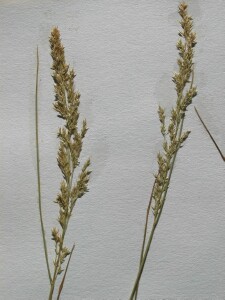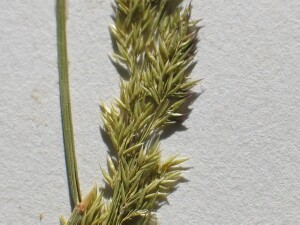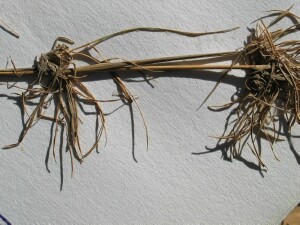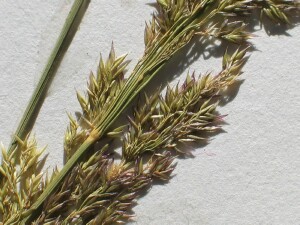Creeping Bent
Back | Salinity Indicator Plants Home | Common name home | Scientific name home | Photo Gallery | Glossary
| Creeping Bent photos | Family: Grass (Poaceae syn. Gramineae) |
| Scientific Name: | Agrostis stolonifera |  Flower-heads of Creeping Bent Photo: A J Brown | |||||
Status: | Native to Europe, Asia and North America. | ||||||
Plant Description: | Perennial grass with long leafy stolons (above-ground, trailing stems that root at their nodes) and sometimes short rhizomes (underground stems). Erect stems to 70 cm high with hairless, mainly flat leaves to 20 cm long and 4 mm wide. The membranous ligules at the junction of stem and leaf blade are generally shorter than broad. Flower-heads are rather dense panicles with spikelets occurring below half the length of the branches and often contracting when mature. Spikelets are single flowered, each floret about 1.5 mm long, without hairs and generally awnless. | ||||||
Habitat: | Scattered across southern Victoria, on swamps, roadside drains and wet depressions.
| ||||||
Comments: | Very similar to Brown-top Bent (Agrostis capillaris) which differs in being strongly rhizomatous, having ligules longer than broad and maintaining an open panicle at maturity devoid of spikelets below half the branch length. Brown-top Bent is a common weed of pastures, roadsides and waste places and tends to prefer drier sites than Creeping Bent. Creeping Bent is also similar to Water-bent (Polypogon viridis) which grows in similar wet environments but has smaller flower-heads with spikelets right to the base of its branches; giving each branch a clustered or lobed appearance. The spikelets of Water-bent fall as a whole when mature, whereas the flower-heads of Creeping Bent and Red-top Bent discard the florets only, leaving the glumes behind. Because of their ability to form dense mats, Creeping Bent and Brown-top Bent are grasses commonly used for sporting turf and lawns with many cultivars developed through breeding programs. |
 Spikelets of Creeping Bent Photo: A J Brown |  Ligule of Creeping Bent at the stem and leaf blade junction Photo: A J Brown |
|
|




